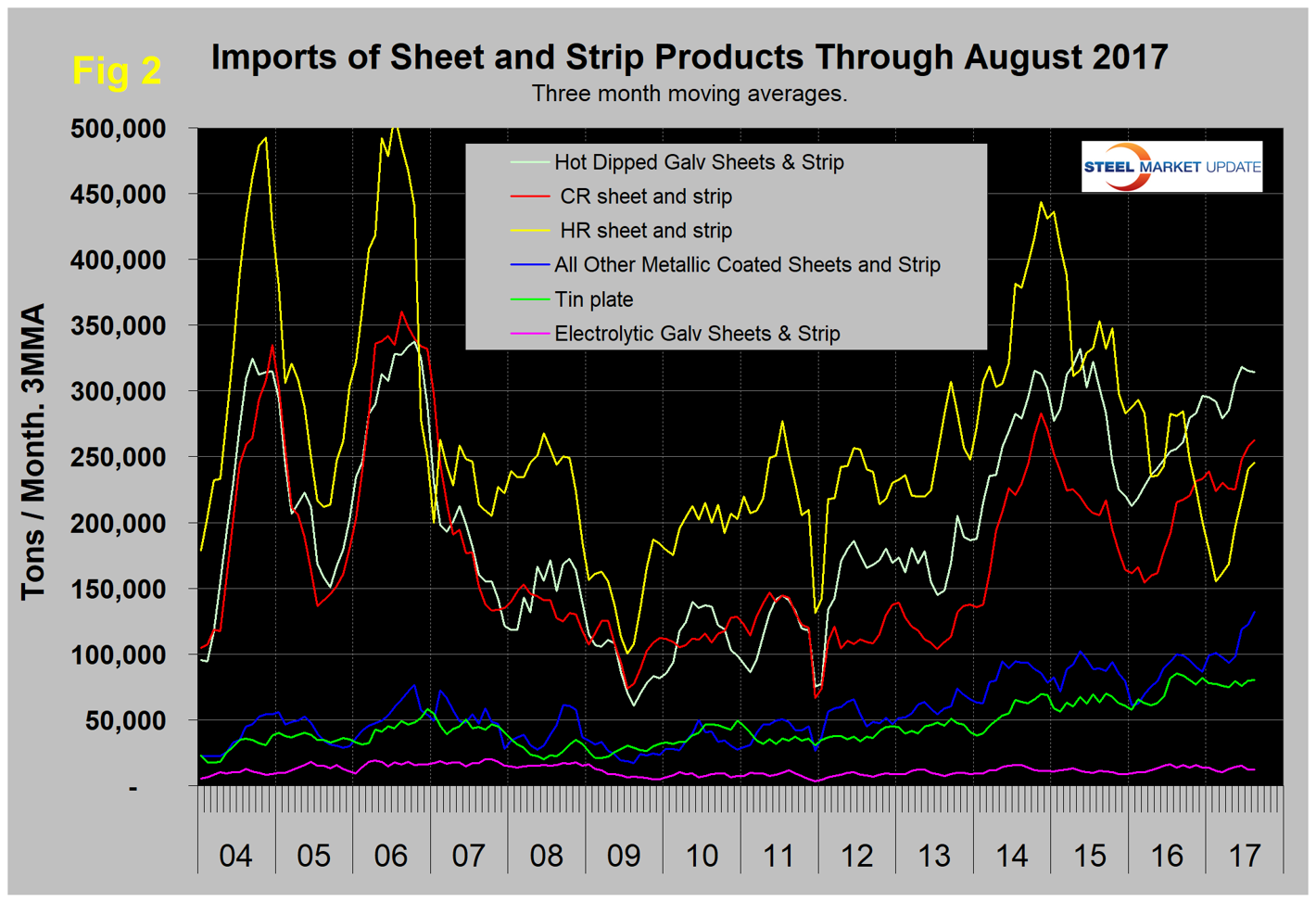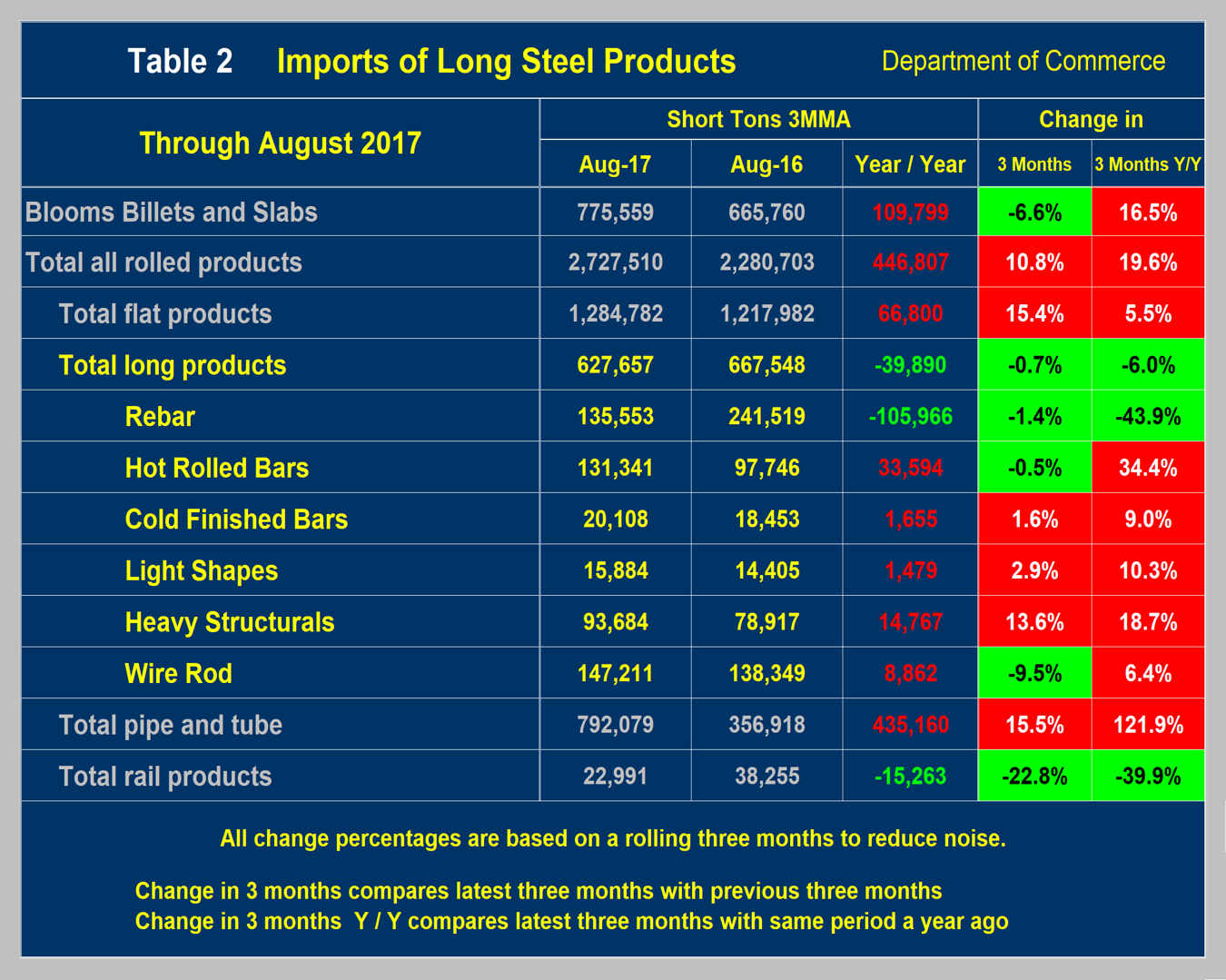Prices

September 8, 2017
Flat Rolled Steel Imports on the Increase
Written by Peter Wright
Total rolled steel imports increased by 10.8 percent in the three months through August compared to the three months through May. Sheet product imports rose by 14.3 percent on the same basis, according to final license data for August reported by the U.S. Commerce Department on Aug. 6.
The data is reported within the Steel Import Monitoring and Analysis (SIMA) system. An explanation of the methodology used to analyze the trade data is given at the end of this piece, together with notes describing SIMA. All volumes are reported in short tons.
The three-month moving average (3MMA) of rolled product imports in August was the highest since May 2015. The August increase was all in flat rolled. Semis and long products declined. Total rolled product licensed imports in the single month of August were 2,532,496 tons with a 3MMA of 2,727,510 tons. We prefer not to dwell on single-month results because of the extreme variability that can occur in individual products. In the comments below, we use three-month moving averages to give what we believe is the most accurate picture.
Figure 1 shows the 3MMA through August of licensed tons of semi-finished, flat and long products since January 2004.
Imports of semi-finished in August had a 3MMA of 775,559 tons, which was up by 16.5 percent year over year. “Flat” includes all hot and cold rolled sheet and strip, plus all coated sheet products, plus both discrete and coiled plate. The 3MMA of flat rolled imports was 1,284,782 tons in August, which was the most since September 2015. Long product imports have been range bound between 519,000 tons and 772,000 tons since August 2014 with no trend evident. In August 2017, the 3MMA of long product imports was 627,657 tons.
Figure 2 shows the 3MMA trend of sheet and strip product imports since January 2004. The total of these products was up by 14.3 percent in three months through August compared to three months through May and up by 10.6 percent year over year.
HRC imports declined sharply in the five months through February, but have increased since. CRC and HDG are currently both higher than HRC on a 3MMA basis, which is very unusual. Other metallic coated (OMC), mainly Galvalume, increased sharply by 35.2 percent in three months through August compared to three months through May. Tin plate and electrogalvanized imports have been relatively flat for over a year.
Table 1 provides an analysis of major product groups and of sheet products in detail. It compares the average monthly import tonnage in the three months through August 2017 with both three months through May (3M/3M) and the three months through August 2016 (Y/Y).
Imports of all sheet products except electrogalvanized were up in the three-month comparison led by other metallic coated. Only HRC, electrogalvanized and tin plate had any relief compared to the year-ago results. Plate was up by 21.9 percent. Year over year, the total of all rolled product imports was up by 19.6 percent, plate products were down by 15.5 percent, total sheet products were up by 10.6 percent, tubulars were up by 121.9 percent and long products were down by 6.0 percent.
There were big differences between the individual sheet products compared to last year, ranging from HRC, down by 12.7 percent, to other metallic coated, up by 32.2 percent. Table 2 shows the same analysis for long products. The total tonnage of long product imports was down by 39,890 tons per month Y/Y. On a 3M/3M basis, the total volume of long products declined by 0.7 percent.
Figure 3 shows the import market share of sheet and long products through June, which is the latest data available. The import market share of sheet products peaked at 24.3 percent in March 2015. The June 2017 level was 21.3 percent. Long product import market share has been considerably higher than for sheet products since early 2015 and in June was 28.7 percent, the highest since May 2015.
Figures 4 through 7 show U.S. mill shipments to domestic locations, imports and import market share for the four major sheet products. Note that the righthand import share axes are the same to give true comparability. HRC has the lowest import share followed by HDG, CRC and OMC, which is by far the highest.
Our analysis is based on the final import volumes through June. Net imports equals imports minus exports.
We regard this as an important look at the overall trade picture and its effect on demand at the mill level. Figure 8 shows net sheet product imports on a 3MMA basis to be 625,395 tons in June, which was the highest since September last year. Exports have increased in 2017, driven by the depreciation of the U.S. dollar on the international foreign exchange markets. Net sheet steel imports are high by historical standards.
Explanation: SMU publishes several import reports ranging from this very early look using licensed data to the very detailed analysis of final volumes by product, by district of entry and by source nation, which is available on the premium member section of our website. The early look, the latest of which you are reading now, has been based on three-month moving averages (3MMA) using the latest licensed data, either the preliminary or final data for the previous month and final data for earlier months. We recognize that the license data is subject to revisions, but believe that by combining it with earlier months in this way gives a reasonably accurate assessment of volume trends by product as early as possible. We are more interested in direction than we are in absolute volumes at this stage. The main issue with the license data is that the month in which the tonnage arrives is not always the same month in which the license was recorded. In 2014, our data showed that the reported licensed tonnage of all carbon and low alloy products was 2.3 percent less than actual receipts, close enough we believe to confidently include licensed data in this current update. The discrepancy declined continuously during the 12-month evaluation as a longer time period was considered.
Statement from the Department of Commerce: The Steel Import Monitoring and Analysis (SIMA) system, under the Department of Commerce, collects and publishes data of steel mill product imports. By design, this information provides stakeholders with valuable information on steel trade with the United States. This is achieved through two tools: the steel licensing program and the steel import monitor. All steel mill imports into the United States require a license issued by the SIMA office. The SIMA Licensing System is an online automatic system for users to register, apply for and receive licenses in a quick and timely manner. This online system allows importers to process imports with minimal effort and added efficiency. In addition to managing the licensing system, SIMA publishes near real-time aggregate data on steel mill imports into the United States. These data incorporate information collected from steel license applications and publicly released Census data. The data are displayed in tables and graphs for users to analyze various levels and changes in steel trade involving the United States. Additionally, SIMA provides data on U.S. steel mill exports, as well as imports and exports of select downstream steel products.

















